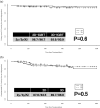A retrospective study of locally advanced cervical cancer cases treated with CT-based 3D-IGBT compared with 2D-IGBT
- PMID: 37140821
- PMCID: PMC10543524
- DOI: 10.1007/s11604-023-01439-6
A retrospective study of locally advanced cervical cancer cases treated with CT-based 3D-IGBT compared with 2D-IGBT
Abstract
Purpose: To retrospectively review locally advanced cervical cancer (CC) cases treated with three-dimensional image-guided brachytherapy (3D-IGBT) and two-dimensional (2D)-IGBT.
Materials and methods: Patients with Stage IB-IVa CC who underwent intracavitary irradiation between 2007 and 2021 were divided into the 3D-IGBT and 2D-IGBT groups. Local control (LC), distant metastasis-free survival (DMFS), progression-free survival (PFS), overall survival (OS), and gastrointestinal toxicity (G3 or more) were investigated at 2/3 years post-treatment.
Results: Seventy-one patients in the 2D-IGBT group from 2007 to 2016 and 61 patients in the 3D-IGBT group from 2016-2021 were included in the study. The median follow-up period was 72.7 (4.6-183.9) months in the 2D-IGBT group and 30.0 (4.2-70.5) months in the 3D-IGBT group. The median age was 65.0 (40-93) years in the 2D-IGBT group and 60.0 (28-87) years in the 3D-IGBT group, but there was no difference in FIGO stage, histology, or tumor size between the groups. In treatment, the median A point dose was 56.1 (40.0-74.0) Gy in the 2D-IGBT group and 64.0 (52.0-76.8) Gy in the 3D-IGBT group (P < 0.0001), and the proportion of patients who underwent chemotherapy more than five times was 54.3% in the 2D-IGBT group and 80.8% in the 3D-IGBT group (P = 0.0004). The 2/3-year LC, DMFS, PFS, and OS rates were 87.3%/85.5%, 77.4%/65.0%, 69.9%/59.9%, and 87.9%/77.9% in the 2D-IGBT group, and 94.2%/94.2%, 81.8%/81.8%, 80.5%/80.5%, and 91.6%/83.0% in the 3D-IGBT group, respectively. A significant difference was observed in PFS (P = 0.02). There was no difference in gastrointestinal toxicity, but there were four intestinal perforations in the patients from the 3D-IGBT group, three of whom had a history of bevacizumab treatment.
Conclusion: The 2/3-year LC of the 3D-IGBT group was excellent and PFS also tended to improve. Care should be taken with concomitant use of bevacizumab after radiotherapy.
Keywords: Bavazcizumab; CT-based 3D-IGBT; Locally advanced cervical cancer; Outcome.
© 2023. The Author(s).
Conflict of interest statement
The authors declare that they have no conflict of interest.
Figures



References
-
- American Cancer Society, Cancer Facts & Figures 2020. https://www.cancer.org/content/dam/cancer-org/research/cancer-facts-and-... (Accessed 10 2020) - PMC - PubMed

